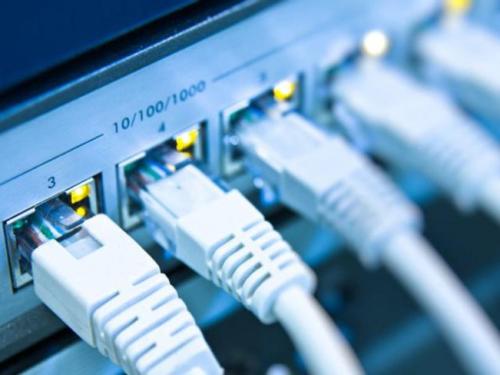Ethernet is the most common communication protocol standard used in existing local area networks today. This standard defines the cable types and signal processing methods used in LAN). Ethernet transmits information packets between interconnected devices at a rate of 10~100Mps. Ethernet using twisted pair cable 10Base T has become the most widely used Ethernet technology due to its low cost, high reliability and 10Mbps rate.
At present, Ethernet has developed to the rate of 10G, and the 10G Network Alliance has been established. The original IPV4 address resources have been exhausted, and the new IPV6 technology is about to be put into operation.
According to statistics, 85% of the world’s networks currently use Ethernet technology. my country’s major operators have basically completed the construction of their own backbone transmission networks, and metropolitan area networks have become the focus of competition among operators. With the continuous development and improvement of Ethernet technology and standards, Ethernet technology has become mature and can provide users with network services of different QoS. The next ten years will be a period of rapid development of metropolitan Ethernet technology.
The Origin of Ethernet
Ethernet was introduced in the mid-1970s by Xerox Corporation’s Palo Alto Research Center. Due to the development of media technology, Xerox can connect many machines to each other to form giant printers, that is, shared printers. This is the prototype of Ethernet. Later, Xerox launched an Ethernet with a bandwidth of 2Mb/s, and cooperated with Intel and DEC to launch an Ethernet with a bandwidth of 10Mb/s. This is commonly known as Ethernet I or Ethernet DIX (Digital, Intel and Xerox). IEEE (Institute of Electrical and Electronics Engineers) is an association with 802 committees. After its establishment, it formulated the standards for Ethernet media. Among them, IEEE802.3 is very similar to Ethernet launched by Digital, Intel and Xerox.
Why use Ethernet?
Serial servers are used to connect devices on the network and remain a popular form of network connection. For local networks used by specific organizations such as corporate offices, school campuses, and hospitals, Ethernet is used for its high speed, security, and reliability.
Ethernet initially gained popularity for being cheap compared to competing technologies at the time, such as IBM’s Token Ring. As network technology advances, Ethernet continues to evolve and deliver higher performance levels while maintaining backward compatibility, ensuring Ethernet’s continued popularity. Ethernet’s original 10 megabits per second throughput increased tenfold to 100 Mbps in the mid-1990s, and the Institute of Electrical and Electronics Engineers (IEEE) continues to provide updated performance. Current versions of Ethernet can support operation at up to 400 gigabits per second (Gbps).
advantage
● Relatively low cost;
● Backward compatibility;
●General anti-noise;
● Good data transmission quality;
● Fast;
● High reliability and high data security.
shortcoming
● It is suitable for smaller, shorter distance networks.
●Liquidity is limited.
● Using longer cables can cause crosstalk.
● It is not suitable for real-time or interactive applications.
● The increase in traffic causes the Ethernet speed to decrease.
● The receiver does not acknowledge receipt of the packet.
● When troubleshooting, it can be difficult to track down the specific cable or node that is causing the problem.

Ethernet vs. Wi-Fi
Wi-Fi is the most popular type of network connection. Unlike wired connection types such as Ethernet, it does not require physical cables to be connected. Data is transmitted via wireless signals.
Difference Between Ethernet and Wi-Fi Connections
● Ethernet connection
● Transmitting data through cables;
● Reduced mobility – requires the use of physical cables;
● Higher speed, reliability and security than Wi-Fi;
● Consistent speed;
● No data encryption is required;
● Lower latency;
● More complex installation process.
Wi-Fi connection
● Transmit data via wireless signals rather than through cables;
● Better mobility as no cables are required;
● Not as fast, reliable or secure as Ethernet;
● More convenient – users can connect to the network from anywhere;
● Inconsistent speeds – Wi-Fi is susceptible to signal interference;
● Data encryption is required;
● The delay is higher than Ethernet;
● Easier installation process.
How Ethernet works – CSMA/CD
Ethernet uses CSMA/CD (Carrier Sense Multiple Access with Collision Detection, Carrier Sense Multiple Access with Collision Detection) to work. The node that needs to transmit data on the Ethernet segment monitors the wire. This process is called carrier sensing of CSMANCD. If there is another node transmitting data at this time, the listening node will have to wait until the transmission task of the transmitting node ends. If there are exactly two workstations preparing to transmit data at the same time, the Ethernet segment will send out a ” conflict” signal. At this time, all workstations on the node will detect conflicting signals because the voltage on the wire exceeds the standard voltage. After the conflict occurs, both nodes will immediately send out congestion signals to ensure that each workstation detects that a conflict has occurred on the Ethernet and the bandwidth on the wire is 0Mb/s (no traffic). The network then recovers, and no data is transmitted on the wires during the recovery process. In this process, nodes that do not belong to the network segment where the conflict occurs must wait until the conflict is over before they can transmit data. When the two nodes have finished transmitting the congestion signal and a random period of time has passed, the two nodes begin to restore the signal to zero. The first station to reach the zero position will first listen to the wire, and when it hears that nothing is being transmitted, it will begin transmitting data. When the second workstation returns to the zero position, it also monitors the wire. When it hears that the The first workstation has started transmitting data, it has no choice but to wait.
Mots-clés dans cet article : Ethernet transmission de données équipement